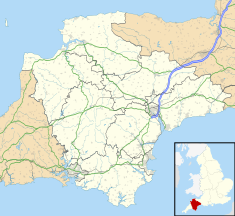| Plymouth Guildhall | |
|---|---|
 The west front of the guildhall | |
| Location | Plymouth, Devon |
| Coordinates | 50°22′11″N 4°08′29″W / 50.369791°N 4.141469°W |
| Built | 1874 |
| Architect | Norman and Hine |
| Architectural style(s) | Gothic Revival style |
Listed Building – Grade II | |
| Designated | 1 May 1975 |
| Reference no. | 1113280 |
Plymouth Guildhall is located on Guildhall Square in the city centre of Plymouth, Devon, England. It is a Grade II listed building.[1]
YouTube Encyclopedic
-
1/1Views:551
-
Devon Tourism Awards 2017/18
Transcription
History
The first guildhall can be dated back to the 15th century and is believed to have been located in the Old Town; it was replaced by a second guildhall which was erected in the Southside Street / Woolster Street area in 1440.[2] A third guildhall was built in the Jacobean style at the junction of High Street and Whimple Street in 1607; this was demolished to allow a fourth guildhall, designed by a Mr Eveleigh, to be built and completed in 1800.[2]
The foundation stone for the current building, which was the fifth, was laid by the mayor, William Luscombe, on 28 July 1870.[3] It was designed by Norman and Hine of Plymouth with artistic direction by Edward William Godwin in the Gothic Revival style and built by Messrs Call and Pethick.[3] The building was one of a pair of civic buildings on opposite sides of Guildhall Square which were built at the same time; facing it on the north side of the square was the Municipal Offices, which housed the council's administrative offices and council chamber. The guildhall incorporated courtrooms and a great hall for ceremonial functions and public events. Both buildings were officially opened by Prince of Wales on 13 August 1874.[3][4]
The design for the west front of the guildhall, where the entrance now is, involved an octagonal tower on the left and a 50 meters (160 ft) high square tower on the right.[5] Internally, the principal room was the Great Hall: a pipe organ, made by Henry Willis & Sons, was installed in the hall and the first recital given on 22 October 1878.[6]
The guildhall and the surrounding buildings, including the municipal offices, were reduced to shells on the night of 21 March 1941 during the Plymouth Blitz of the Second World War.[3] The ruins of the municipal offices were demolished and not rebuilt.[4] Paton Watson and Patrick Abercombie envisaged a Beaux Arts city which would have involved the demolition of the Guildhall: their proposal was rejected by one council vote in 1951.[1] Following the restoration of the building, which involved a new roof, entrances and interior, the building was re-opened by Field Marshal the Viscount Montgomery of Alamein on 24 September 1959.[3]
A new headquarters for the city council was completed in 1962 at the Civic Centre, located a short distance to the west of the guildhall.[7] Meanwhile, the assize courts, which had met in the guildhall, moved to the new Law Courts in Armada Way in 1963.[8]
Description
The Great Hall is currently a multi-purpose venue, hosting a range of events throughout the year including graduations, award ceremonies, weddings and civil ceremonies.[9] Fourteen stained glass windows, designed by Frederick Halford Coventry (1905-1997), line the sides of the hall and depict notable moments in Plymouth's history.[10] A large 19th century tapestry, made at Gobelins Manufactory, hangs at the front and depicts Raphael's vision of the "Miraculous Drought of Fishes".[10] Famous performers in the hall have included the rock bands The Who in December 1965,[11] Status Quo in March 1973[12] and Queen in March 1974,[13] as well as the European Union Chamber Orchestra conducted by Julian Lloyd Webber in April 2009.[14][15]
References
- ^ a b Historic England. "Guildhall including Great Hall, Assize Courts and former City Treasury, City of Plymouth (1113280)". National Heritage List for England. Retrieved 26 August 2019.
- ^ a b "Guildhalls". Plymouth.data. Archived from the original on 8 June 2013. Retrieved 22 August 2020.
- ^ a b c d e "Present Guildhall". Plymouth.data. Archived from the original on 29 May 2013. Retrieved 22 August 2020.
- ^ a b "Municipal Offices". Plymouth Data. Archived from the original on 29 May 2013. Retrieved 10 August 2023.
- ^ "Plymouth Guildhall". Emporis. Retrieved 22 August 2020.[dead link]
- ^ Smart, Jason (1 December 2007). "The Organ of Plymouth Guildhall" (PDF). Plymouth Organists. Retrieved 22 August 2020.
- ^ "Plymouth, Civic Centre". Plymouth.data. Archived from the original on 20 May 2013. Retrieved 24 July 2017.
{{cite web}}: CS1 maint: bot: original URL status unknown (link) - ^ "Courts of Justice". Old Plymouth. Retrieved 17 March 2023.
- ^ "Plymouth Guildhall". www.plymouth.gov.uk. Retrieved 1 December 2018.
- ^ a b "Celebrate, Share, Love Your Guildhall" (PDF). Retrieved 22 August 2020.
- ^ Neill, Andrew; Kent, Matthew (2009). Anyway, Anyhow, Anywhere: The Complete Chronicle of the WHO 1958–1978. Sterling Publishing Company. p. 303. ISBN 978-1402766916.
- ^ "Status Quo Gigography and Live Tapes Archive". Retrieved 22 August 2020.
- ^ "Plymouth Guildhall". Setlist. Retrieved 22 August 2020.
- ^ "European Union Chamber Orchestra". Plymouth Pavilions Classical Concert Series. Retrieved 22 August 2020.
- ^ "The Great Hall". www.plymouth.gov.uk. Archived from the original on 2 December 2018. Retrieved 22 August 2020.

